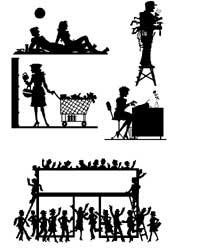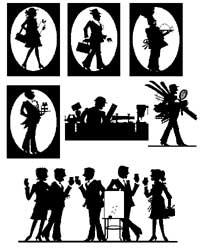Democracy in the air
Today, decision-making is constant. And many of them must be part of a group. If everyone agrees there is no problem. But what to do when opinions are different?
Throughout history various ways have been followed to make group decisions: from a moral law, regardless of the opinion of the group (dictatorships), ... In this article we will analyze democratic decisions and raise the problem as follows:
Suppose we have to sort several options based on their suitability or other criteria. Each team member should express their opinion on all options: if the ones we have are x, y and z, they should indicate if they prefer x and (x > and we will indicate in writing). That is, each team member must decide an order. The first condition that orders must meet is clear: if x > y > z is met that x > z.

This property that must fulfill the order of each member of the group is called transmissiveness, and if the members of the group are not irrational we can consider it real. However, when there are many possibilities, group members may be mistaken (humans have limited memory) and give orders that are not transitive. But we consider that all ordinances are transitory. We also want to avoid dictatorship, imposition and interference. We will give the same value to the votes of all team members.
And now, how to complete the team decision?
When the options to compare are only two, there is no problem: if in the referendums the number of statements exceeds that of negative, the result is positive. But what to do when the possibilities are multiple?
Zurruteroa, rye and mountaineer
Three friends see a prize and do not agree on how to use the money. Zurruteroa proposes buying a bar. Who prefers to have money in the bank. The mountaineer wants a house under Txindoki. After a long debate, here are his positions:
The Zurrutero is still the same: he wants a bar, but he prefers to have money in the bank than to buy a house under Txindoki. Zekena, meanwhile, prefers the mountain house to the tavern. The mountaineer, like his friends, is heady, but he prefers money in the bank than the bar.
In short,
Zurruteroak: bar > etxea > Zekenak: bank > house > bar Mendizaleak:etxea > bank > bar
If we make a simple count by couples, we would see that those who prefer the house to the tavern are most (mountaineers and knights). It is also the majority who prefer the bank than the house. And in the last comparison they win those who prefer the bank than the bar.
Therefore, if we decide democratically, banking > etxea > bar would be the consensus ordering and therefore money would remain in the bank. The second option is the house. Therefore, it would be better for the leftover to abandon those people and pass through another gang.
But since the mountaineer is very fast, he proposes to others: “... after all, the house and bar are compatible, so we should decide if we buy the house or if we had money in the bank. Then we will see if we put the bar in the basement of the house or not.” If he convinced the others, to make the decision in two votes, in the first vote would decide to buy the house comparing the options; in the second vote, being the option the house without bar and the house with bar, would be victorious the house without bar. This would decide what the mountaineer wants.
Is this procedure suitable for couples? Despite the mountaineer’s “intrigue”, it seems like it does. But...
Suppose in a group of 50 people you have to form an opinion on three options. All individual opinions are collected for this purpose. If we know a little combinatorics, it is clear 3! = 6 (number of options) different commands. The results are:
1 x > and > z ........... 19 people 2 x > z > and .....................................................................................................................................................................................................................................................
Let's take all the options by couples:
How many prefer x to y? 1. Those who have chosen the 2nd and 5th order are: 19 + 0 + 9 = 28 people in total. Therefore, most people prefer x and.
How many prefer x to z? 1. Voters in favor of the 2nd and 3rd order: 19 + 0 + 2 = 21 people in total. In this case they do not reach the 25 votes, so the majority are those who prefer z x.
Finally, 34 people prefer and that z.

In short, x > y, z > x e y > z is the decision of the group according to the couples procedure. Stick a little to the head: there is contradiction in the collective decision. In fact, if x > y and z > x are fulfilled, depending on the transversality, z > y must be fulfilled, but in the vote it has been considered preferable to y. Therefore, the procedure that seemed so appropriate has been lowered: the couple procedure may not be consistent. And now what to do?
The criteria for decision-making are framed within the theory of social selection. This field arises as a solution to some problems of economic theory. Its origin is ancient: The Marquis of Condorcet discovered in 1785 the previous contradiction. Economist Arrow demonstrated in 1951 that democracy becomes a dictatorship in Social Choice and Individual Values. Since then, new procedures have been developed for group decision-making. Some of them are incontradictory, but in order to use these criteria, conditions are required that are hardly met in reality. For example, as in the procedure by couples it is assumed that in many criteria you can order the options, but many times it is not possible to do it: for example, it is difficult to say what is the most beautiful in two girls (it happens to me like this!) ).
This field of economic science can also be used at the business level to prioritize investments. For example, by classifying investment options according to the criteria considered, which investments have been prioritized? If we consider the criteria as voters and give the same importance to each criterion, the procedure by couples can be used to determine the most appropriate investment. But there are more appropriate decision criteria for: The ELEKTRA criterion, for example, is often used in companies to make decisions at the steering committee level. But we leave this for another.
Buletina
Bidali zure helbide elektronikoa eta jaso asteroko buletina zure sarrera-ontzian











